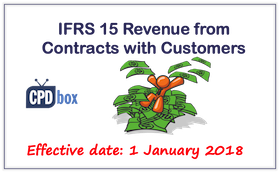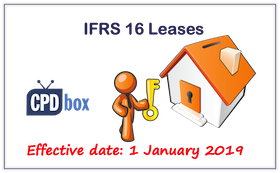IFRS 2019 Update: Major changes you should be aware of
Here we go again – another year has started and a number of changes or amendments of IFRS came into effect.
I am pretty sure that you are aware of the biggest ones like new IFRS 16, but let me sum up all the new things so that you keep them in mind.
In this article, I will try to touch ALL changes or amendments and you read till the end (or scroll down if you are in a hurry), you can find the table summarizing it all.
Standards and amendments effective from 1 January 2018
I know I know – we are in 2019 now.
But, if you work on the closing of your 2018 financial statements, then this short summary comes in very handy.
Just bear in mind that the following changes apply from 1 January 2018, and you might need to restate your 2017 comparative numbers, too.
Here’s the list:
#1: The new standard IFRS 9 Financial Instruments applies fully

The standard IAS 39 no longer applies and your financial statements for the year ended 31 December 2018 need to be prepared under IFRS 9.
IFRS 9 is really complex and even if you don’t work for a financial institution, you should familiarize yourself at least with the new methodology for bad debt provisioning related to your trade receivables.
I have written many articles and podcasts about IFRS 9 and you can find full complex materials here and full videos with lots of case studies here.
#2: The new standard IFRS 15 Revenue from Contracts with Customers applies fully

Forget about IAS 18 Revenue.
You can find a lot of free materials about IFRS 15 here and the videos with step-by-step guides and lots of case studies here.
#3: Amendment of IFRS 2 Share-based Payment
The standard IFRS 2 was amended by the clarifications related to classification and measurement of certain share-based payment transactions.
More specifically:
- IFRS 2 now contains the accounting requirements related to treatment of vesting and non-vesting conditions in cash-settled share-based payment transactions;
- The guidance on share-based payment transactions with a net settlement feature for withholding tax obligations was added,
- IFRS 2 introduced new accounting requirements for modifications of share-based payment transactions from cash-settled to equity-settled.
All these amendments shall be applied prospectively.
#4: Amendment of IFRS 4 Insurance Contracts
Two new standards, IFRS 9 Financial Instruments and new IFRS 17 Insurance Contracts have different effective dates and this could cause some inconsistencies and troubles in reporting by insurance companies.
Therefore, this amendment should remove these issues by permitting two options for the issuers of insurance contracts:
- Overlay approach; and
- Deferral approach (here, the entity would be allowed to apply IAS 39 instead of IFRS 9 until IFRS 17 becomes effective).
Both approaches are optional.
#5: Amendments to IAS 28 Investments in Associates and Joint Ventures
The new clarification was added to IAS 28.
When an entity is a venture capital or similar organization, it can elect to measure the investment in joint venture or associate at fair value through profit or loss in line with IFRS 9 (no equity method).
The amendment clarified that this option is available on investment-by-investment basis upon initial recognition (no need to apply for the whole portfolio).
#6: Amendment to IAS 40 Investment Property
This amendment is applicable for the periods starting on or after 1 July 2018 (no need to apply for the annual statements for the year ended 31 December 2018 then).
The amendment clarified transfers of a property to or from investment property.
Such a transfer is possible only when there is evidence of change in use.
However, the change in management’s intentions for the use of a property is NOT an evidence of change in use.
Standards and amendments effective from 1 January 2019
#1: New IFRS 16 Lease becomes effective

Older IAS 17 Leases becomes superseded and you can no longer apply it.
So, you better start revising all your lease contracts to identify whether you have a lease or not.
If you are a lessee with some operating leases, then you need to start recognizing lease liability and right-of-use asset instead of booking all payments straight in profit or loss.
I wrote many articles and published some videos about IFRS 16, so please take a look here.
If you need to learn it systematically, step-by-step, with calculations – then I frankly recommend the IFRS Kit, it will certainly help!
#2: Amendment to IAS 19 Employee Benefits
The amendment relates to defined benefit plan changes, such as plan amendment, curtailment and settlement.
In each of these changes, you must remeasure your defined benefit plan liability – that was clear even before the new IAS 19 change.
However, IAS 19 update prescribes that you have to use the same assumptions for calculating your current service cost and the net interest for the period after the change as you used for the remeasurement itself (no original assumptions).
IAS 19 update also clarified the impact of plan changes (amendment, curtailment or settlement) on asset ceiling.
#3: Amendments to IFRS 3 Business Combinations and IFRS 11 Joint Operations
Both amendments are closely related and deal with the changes in a group composition.
More specifically:
- If an entity obtains control of another entity that was joint operation (i.e. joint operation becomes subsidiary), then the parent DOES remeasure previously held interest in the subsidiary.
- If an entity obtains joint control of another entity that is a joint operation, then the investor does NOT remeasure previously held interest in the joint operation.
#4: Amendment to IFRS 9 Financial Instruments
Oh yes, here we go.
The standard IFRS 9 has been effective from January 2018, yet after its first year, we have an amendment.
This amendment relates to the classification of certain financial assets, namely those with specific prepayment options.
Let me explain this a bit more since I received some questions what the negative compensation in prepayment option is.
You should classify financial assets as at amortized cost ONLY when they meet two tests:
- Business model test, and
- Contractual cash flow characteristics test.
However, when lenders (banks in most cases) generate loans with prepayment features with negative compensation, the problem is that the cash flows from such loans might not represent solely payments of principal and interest and thus the loan would not meet contractual cash flow characteristics test.
As a result, all the loans with similar prepayment features could not be classified at amortized cost.
Hm, what the prepayment feature with negative compensation is?
Prepayment feature means that the borrower can repay the loan earlier than according to the original schedule.
Sometimes, the contract may permit the borrower to early repay the loan at an amount calculated based on loan’s fair value (i.e. cash flows discounted at a current market rate), not at its amortized cost.
In this case, it can happen that the loan’s fair value at the repayment date would be lower than the outstanding principal and effectively the lender has to accept the lower payment.
In this case, the lender is in effect providing compensation to the borrower, or said precisely – this prepayment includes some portion that is compensation from the lender to the borrower.
And exactly this compensation is a problem, because it does not represent the cash flow arising solely from payments of interest and principal.
The recent amendment of IFRS 9 introduced so-called narrow-scope exception to the classification rules meaning that similar financial assets can be measured at amortized cost or at fair value through other comprehensive income.
Besides changes related to classification of financial assets with prepayment options, this amendment also clarified accounting for modification of the financial liabilities.
#5: Amendment to IAS 12 Income Taxes
The amendment in IAS 12 is more clarification than the substantial change.
It clarifies the recognition and measurement of current and deferred taxes on dividends.
#6: Amendment to IAS 23 Borrowing Costs
IAS 23 was amended by the clarification.
If any specific borrowing remains outstanding after the related asset is ready, then this borrowing becomes a part of general borrowings.
It means that you should calculate the capitalization rate on general borrowings taking the specific borrowing on completed asset into account (if outstanding).
Standards and amendments effective from 1 January 2020 and later
Let me sum up the new developments in IFRS applicable in the near future, from 2020 and later.
#1: New standard IFRS 17 Insurance was issued in 2017

The standard will replace IFRS 4 Insurance Contracts.
#2: Amendment in IFRS 3 Business Combinations
The newest amendment brings new definition of business.
It is very important to distinguish between the situation when the investor acquires a business or when the investor acquires just a group of assets.
The reason is that the accounting method for the new acquisition depends on what it is:
- If you acquire a business, then you apply full consolidation method under IFRS 3,
- If you acquire a group of assets, then you apply different accounting method, e.g. under IAS 16 Property, plant and equipment or under IFRS 11 Joint Operations, or other.
The new amendment of IFRS 3 changed only the Appendix A with Defined terms, the application guidance and the illustrative examples – thus no changes in the standard’s articles itself.
The changes clarify the requirements for the acquisition to be a business and add guidance and illustrative examples.
I will write an article or a new podcast episode on this topic a bit later.
This change is effective from 1 January 2020.
#3: Amendments to IAS 1 and IAS 8
The amendment relates to the definition of material information.
According to the new definition, information is material if omitting, misstating or obscuring it could reasonably be expected to influence decisions that the primary users of general purpose financial statements make on the basis of those financial statements, which provide financial information about a specific reporting entity.
The new items in a definition are highlighted above and as you can see, the definition became more precise.
In relation to materiality, I would like to draw your attention to the Practice Statement 2, issued in September 2017, called Making Materiality Judgments.
Summary of changes in IFRS 2019
The following table quickly summarizes all the changes described in this article, applicable in the near future or recently adopted.
The changes in the table are arranged by the standards, not by the date.
| Standard | Issued | Effective date | Subject |
| IFRS 1 | 8 Dec 2016 | 1 Jan 2018 | Redundant paragraphs deleted |
| IFRS 2 | 20 Jun 2016 | 1 Jan 2018 | Amended by classification and measurement |
| IFRS 3 | 12 Dec 2017 | 1 Jan 2019 | Clarification |
| IFRS 3 | 22 Oct 2018 | 1 Jan 2020 | New definition of “Business” |
| IFRS 4 | 12 Sep 2016 | 1 Jan 2018 | Provisions to ease different effective dates of IFRS 9 and IFRS 17 |
| IFRS 9 | 24 Jul 2014 | 1 Jan 2018 | Complete IFRS 9 applies, including ECL model |
| IFRS 9 | 12 Sep 2016 | 1 Jan 2018 | Provisions to ease different effective dates of IFRS 9 and IFRS 17 |
| IFRS 9 | 12 Oct 2017 | 1 Jan 2019 | Classification of Prepayment Features with Negative Compensation |
| IFRS 11 | 12 Dec 2017 | 1 Jan 2019 | Clarification |
| IFRS 15 | 11 Sep 2015 | 1 Jan 2018 | Complete IFRS 15 is effective |
| IFRS 15 | 12 Apr 2016 | 1 Jan 2018 | Clarifications |
| IFRS 16 | 13 Jan 2016 | 1 Jan 2019 | Complete IFRS 16 is effective |
| IFRS 17 | 18 May 2017 | 1 Jan 2021 | Complete IFRS 17 is effective |
| IAS 1 | 31 Oct 2018 | 1 Jan 2020 | New definition of “Material” |
| IAS 8 | 31 Oct 2018 | 1 Jan 2020 | New definition of “Material” |
| IAS 12 | 12 Dec 2017 | 1 Jan 2019 | Clarification |
| IAS 19 | 7 Feb 2018 | 1 Jan 2019 | Amended by “Plan Amendment, Curtailment or Settlement” |
| IAS 23 | 12 Dec 2017 | 1 Jan 2019 | Clarification related to specific borrowings after the related asset is ready |
| IAS 28 | 8 Dec 2016 | 1 Jan 2018 | Clarification |
| IAS 40 | 8 Dec 2016 | 1 Jul 2018 | Amended by transfers of investment property |
Did this article help you? In this case, please share it with your friends and leave me a comment below. Thank you!
Tags In
JOIN OUR FREE NEWSLETTER AND GET
report "Top 7 IFRS Mistakes" + free IFRS mini-course
Please check your inbox to confirm your subscription.
37 Comments
Leave a Reply Cancel reply
Recent Comments
- ASHAGRE TILAHUN TAYE on IFRS 17 Example: Initial Measurement of Insurance Contracts
- Silvia on Example: IFRS 10 Disposal of Subsidiary
- Silvia on IFRS 17 Insurance Contracts: Summary
- Shiksha on Example: IFRS 10 Disposal of Subsidiary
- Chrisant on IFRS S2 Climate-related Disclosures: What, How, When
Categories
- Accounting Policies and Estimates (14)
- Consolidation and Groups (24)
- Current Assets (21)
- Financial Instruments (54)
- Financial Statements (48)
- Foreign Currency (9)
- IFRS Videos (65)
- Insurance (3)
- Most popular (6)
- Non-current Assets (54)
- Other Topics (15)
- Provisions and Other Liabilities (44)
- Revenue Recognition (26)




I am eager to get this course?
Great and simplified update, thank you so much!
Thank you for your updates.
nicely but more explanation required
HI Silvia,
I need to cite this information in my MBA assignment. May I have your last name please? Thank you.
Thank you! This was very helpful
Thank you very much. Your articles are very helpful to the accountants!
Hi Silvia
I have a question re IFRS 9 amendment – Prepayable financial assets.
Last year company A disposed of business B to buyer C for $10m cash and $225m deferred consideration (loan note) repayable within 6 years. Also, company A is entitled to 20% earn out if business B is sold subsequently by buyer C. Buyer C has option to repay the loan sooner, at value lower than FV of $225m plus earnout.
In 2018 accounts, $225m loan note and earnout were disclosed as financial asset at fair value through profit and loss. 10% credit loss was applied to calculations.
Would amendment to IFRS 9 require to disclose the loan note at amortised cost in 2019 accounts? If so, do I need to restate 2018 accounts? If restatement of 2018 numbers is required, and immaterial, can I include change to 2018 in 2019 accounts?
I hope to hear from you.
Hello Silvia. What about IFRIC-23?
Hi Silvia,
I have two questions about IFRS 16.
1) Could you do an article about separating components and how to allocate consideration to lease and non-lease items as well as property taxes and insurance (given these are variable costs and change each year)?
2) I’ve been told in order to capitalize a land lease, it has to be a long-term lease (i.e. >100 years). Is this true?
Thanks,
Annie
HI!!!! THANK YOU SO MUCH FOR THIS ARTICLE!!!! This is an extremely useful for anyone who wants to update their knowledge of IAS/IFRS. Wishing you all the success in the coming years!
Cheers,
M.S
Thank you so much for the updates..been very helpful before my interview.
Thank you so much.
i would like to thank you in advance for providing useful information to stakeholders
Thank You
Hi Silvia, kindly explain this para thanks “If an entity rents some assets and then ceases to rent them, the assets should be transferred to inventories at their carrying amounts as they become held for sale in the ordinary course of business. [IAS 16.68A]
This is commendable Silvia,
Well done.The article is well laid out and descriptions are apt and concise.
Thanks Silva
Dear Silvia,
Greetings from Nepal.
Thank you for the updates. I am following all of your articles and they are helpful for my day to day job. I am facing some difficulties about how to treat the staff privileged loan facility provided to the staffs ( which are concessional to the current market rate of interest). Can you please help me out to calculate the annual amortized staff cost for the staff privilege loan facilities provided by the financial institutions.
Thank you very much Silvia !
Thanks very much silivia.
It’s great
Thanks a lot!!
Thank you Silvia, for the effort you let us know new things of IFRS.
This is specially helpful for countries like mine, Ethiopia-E.Africa where we start implementing IFRS currently.
Thank you again & appreciate.
Hi Silvia.
First of all, I want to celebrate all of you with welcomed New 2019 year.
Also Thanks for amazing article.
I have a couple of question relating to impairment AR (Accounts Receivable).
a) how we account for inter-group loans in line with IFRS 9, especially its impairment. As you know, Intra-group loans within the scope of IFRS 9 are required to be measured at fair value on initial recognition. Intragroup loans are often either interest-free or they are provided at below-market interest rate. The amount lent is, therefore, not fair value. In this case, how we account for impairment loss on inter-company loans?
b) According to the IFRS 9, simplification of impairment on trade receivables is allowed but after calculating provision matrix, it would be adjusted based on forward-looking estimates if correlations exist between AR and macro-economic factors. Ok, but how we can calculate correlation between those. Can you describe briefly this calculation? Because, I am required to do provision matrix in line with IFRS 9.
Thanks for your cooperation!
Hi Mirolim,
thank you and I wish you Happy New Year, too!
Please note that these questions are off topic and I would like to keep this website tidy and thus all comments relevant. However, as a basic information, you can read this article for a) and this article for b). Also, it is not really possible to share complex methodology and calculations here within articles, so I would kindly recommend my Helpline where all your questions will be answered.
This is so helpful, thank you so much
Great job
Thank you so much
Good update
Hi Silvia,
Thank you so much for the timeous updates.
Many thanks
Hello Silvia, Am CPA Deric Mutoka from Tanzania, your articles are real useful and the package is full, thanks for your tirelessly efforts (of which no price consideration is involved). am real enlighten by each article you send. Wish you the best in 2019 onward.
Dear Deric, thank you very much for your kind words, I really appreciate and I’m happy to help! S.
Good info Silvia. Thanks….
Thanks a lot.
Great work Silvia. Thanks a lot !!!
Very helpful. Indeed you are doing a great work. Thank you.
Great Info Sylvia.
Good update Silvia..Thank you for the update !!!